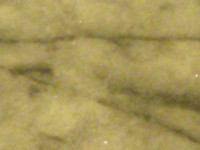Causes and cures (and why we recommend white or very light marble never be used in a shower)
Sitting in my office one morning I received a call from a very upset home builder. He told me he was building a two million-dollar home and had installed nearly 3500 square feet of a white statuary marble tile. Over the weekend one of the water pipes broke in a bathroom and completely flooded the home.
They managed to vacuum all the water and started to assess the damages. Beside warped wood, soaked drywall and an irate homeowner, the marble tile seemed fine except for some minor water spotting. After several weeks the replacement of warped wood and drywall was completed, but he noticed the white marble had turned yellow in many areas. At first he thought it might be some type of residue so they tried cleaning the marble with some bleach and water but the yellowing was still there.
Meanwhile, the homeowner was getting more and more irate and was threatening a lawsuit. It was at this point that he called me.
The problem of yellowed white marble is not uncommon. All over the United States I have encountered marble that has turned yellow, and even brown. Although flooding is a common cause there are several other reasons this color change will occur.
IMPROPER MAINTENANCE
As marble wears, the highly polished surface begins to become scratched and worn. The wearing of this polish causes the surface to become rough and become a magnet for dirt. If improper cleaners are used, this dirt begins to accumulate in the pores of the stone can will turn yellow. It is surprising how often I have seen this condition on marble. Upon investigation in these cases I have often found dirty mops being used. Mops used to clean the restrooms and/or kitchens were also used to clean the marble floors. Floors are mopped with strong cleaners or wax cleaner combinations or with no cleaners at all.
Cure: If you suspect yellowing due to improper maintenance the marble tile will have to be cleaned with an alkaline marble cleaner. I would suggest a heavy duty stone cleaner. Be sure the stone cleaner you buy needs to be alkaline and not an acid since acid cleaners will dull the polish. Apply the cleaner to the marble and scrub with a soft brush. Be sure to rinse the floor thoroughly. It may be necessary to repeat this procedure several times to remove all the imbedded dirt. If after cleaning the marble is dull I would suggest that you call us to professionally re-polish your floors then follow with an application of a good quality penetrating sealer (impregnator). If after several cleanings the yellowing is not removed then consider the next cause.
WAX BUILD-UP OR COATING
Many marble floors are coated with waxes, acrylics, urethane and other coatings. Most of these coatings are not specifically designed for use on marble floors. Some of these coatings are of poor quality and the coatings themselves will begin to yellow. It is not uncommon for coating to be applied in multiple coats. As the coating builds up it becomes soft and dirt is easily embedded in the soft layer. These coatings require frequent stripping which is often neglected.
Another possibility along these same lines is that process sometimes used for polishing marble floors is known as re-crystallazation. If this process is applied to a white marble floor that contains moisture it will turn the marble yellow.
Cure: To remove yellowing due to a wax or coating buildup the marble will need to stripped with a commercial wax stripper. I would strongly suggest having this done by a professional. These strippers often require the use of abrasive pads which can scratch and damage the marble surface. If you do try it yourself, before undertaking the entire project perform a small test to determine results.
If the marble tile has been recrystallized, it will be necessary to remove the recrystallized layer. This layer can often be removed by a professional polishing the tile with a powder marble polish containing oxalic acid. If this technique fails then the tile will have to be re-honed. It is strongly suggested that the polishing and honing procedure be performed by trained individuals. If these techniques fail to remove the yellowing then proceed to the next possible cause.
IRON STAINING
Many white marble tiles contain naturally occurring deposits of iron. Iron is a mineral found in stone and can occur randomly throughout the stone. If iron is present in the marble tile, it will begin to oxidize when exposed to water or other oxidizers such as acids and household bleach.
It is for this reason that we recommend not using white marble in a shower.
White marble tiles can remain for years without yellowing then over time may slowly turn yellow, and in severe causes, may turn completely brown. This oxidation process is accelerated when the tile is saturated as in the flood in the above example. This process of oxidation is similar to the rusting of metal. If you expose a brand new nail to water and air it will turn brown and rust. The same process is occurring with the iron in the marble. If water and/ or air is eliminated the iron will not oxidize. This is the reason certain white marble suddenly turn yellow.
The process is difficult to reverse and replacement of the tile may be necessary. The following stain removal technique has proved successful in several cases. Before testing this procedure it is important to first determine if iron is the cause.
Testing for Iron:
- Before assuming the marble is yellowed due to iron, be sure to attempt cleaning and stripping as outlined in the first two possible causes above. If these procedures fail then testing for iron will be necessary.
- If a flood has occurred or excessive water was used first check the water for iron. If any amount of iron is detected then it is possible iron has entered the stone through the water supply. To eliminate the iron there are chelating chemicals that can be added to the water to prevent the iron from staining. This is very important if the tile is cleaned with this water.
- Even if the water contains no iron the tile can be checked for iron content. We can remove one tile and have it analyzed total iron. If there are spare tiles that have never been installed it would be a good idea to also have them tested for total iron. If iron is present naturally in this stone, it will probably be detected in the spare tiles. If the results return with iron present then the following procedure should be tested.
- We can check the tile for moisture using a moisture meter. If the tile contains water, it is very possible that iron is beginning to oxidize.
The Process for Removing Iron Staining:
- Prepare a solution of water and the following chemical: Sodium Hydro sulfite and Sodium Metabisulfite. These chemicals are available in a product called Iron-Out® you may have seen at your plumbing supply or home center.
- We will mix a solution in water and apply to the effected tile, and allow the solution to soak into tile and kept wet for several hours. It is important that the solution not be allowed to dry. After several hours pick up excess solution with a wet vacuum and rinse thoroughly with water and a chelating agent such as EDTA.
- Be prepared to expect that the marble may need to be repolished since these chemicals can etch marble.
If the above procedure fails we can then prepare a poultice with diatomaceous earth and the Iron Out™. The poultice mixture will be applied to a small area and covered with plastic wrap. After 24 hours remove the poultice paste and rinse the area with water and a chelating agent. If the stain is removed, the entire floor can be treated. If the stain still remains then replacement is the only solution.
NOTE: There are also some new chemicals that are available which contain Ammonium Thioglycolate which look promising for removing iron oxidation.
The yellowing of white marble is a common problem. New installations should be sealed with a good quality penetrating sealer (impregnator) which will help prevent oxidation of the iron by eliminating moisture.


